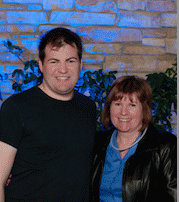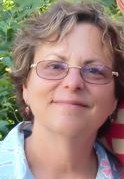
Emily and Tom at World Autism Awareness Day, April 2012
(Image by Renee Bowen Photography) Details DMCA
My guest today is author, producer, professor and consultant, Emily Iland. Welcome to OpEdNews, Emily. You're an expert on ASD [Autism Spectrum Disorder]. Let's start at the beginning. Where did your interest in this field come from?
My son Tom was diagnosed with autism at the age of 13. With a late start, I had to get busy learning all I could about ASD and getting him the help he needed. I wrote my first book to answer the 1,000 questions that all new parents have, to save them the extensive and exhaustive search for unbiased information! My co-author was my sister Barbara Doyle, a professional in the field of ASD even before Tom was born. I went on to translate Autism Spectrum Disorders from A to Z into Spanish [currently out of print] because in my journey I saw how many parents were in the dark about their child's condition and what to do about it.
From there I became an advocate and leader, because autism was not just about my son anymore and there was a lot of work to be done.
I bet. So, your personal situation ended up creating a whole new career path. And beyond that book, which I imagine would be a godsend to so many parents, you've worked extensively to bring ASD know-how to the general public. Can you talk about that a bit?
Tom was mercilessly bullied in elementary school, from about 4th grade on. I realized that children were afraid of differences they did not understand. As a parent volunteer, I developed an experiential program called Appreciating Diversity, that let kids see what it feels like to have a disability like deafness, blindness or learning differences. Helping kids develop empathy is a powerful antidote to bullying. From there, I helped my high school district to bring the Yes I Can Program for Social Inclusion to our district, to help students with and without disabilities get to know one another and make friends. I realize that a lack of understanding creates distance, suspicion or even rejection.
Notice how what I did evolved as Tom got older, and I felt that my efforts needed to be more far-reaching. I did not ever plan to, but I became an advocate, working with hundreds of families, and a non-profit leader. Educating the police about autism came next.
Tell us about how you went about educating the police. Were they initially receptive to your initiative?
I helped form a support group here in Santa Clarita, and the group felt strongly that our sheriffs needed to understand autism. Members of the community were calling the police when our kids had meltdowns at the mall. In spite of parents' best efforts, some children were eloping from home and were in grave danger. Others, like Tom, were being bullied. I was asked to contact the chief and community liaison deputy, who were tremendously open and welcoming, and so our first efforts began.
A group of mothers went to the Sheriff's station with our children so the deputies could meet us and them, know who we are when they see us, and get an idea of the kind of help children with autism might need. I call this approach "The Face of Autism." Our children were very different from one another, even though they had the features of autism in common. We felt it was very important for the deputies to understand the autism spectrum by seeing with their own eyes.
One deputy said something I never forgot, "The more information I have, the better I can do my job." We felt like we were helping make that happen.
Another thing that got the sheriffs on board was their own desire to rescue lost people with autism faster. They were getting a lot of calls. Besides being dangerous for the lost person and upsetting to the families, it was time-consuming and expensive for the department, especially when they had to deploy the search-and-rescue helicopter. So the training was seen as a win-win situation.
How long has this collaboration being going on and how's it doing?
Our local collaboration, started around 1999, continues today. We established a special needs registry that was recognized by the Department of Homeland Security as a model for the nation. We work with community partners to sponsor an Access Hour at our local Safety Expo, where families with someone with any kind of special needs, any age, can come an hour before the event opens to the public for quality time with the first responders. This is a wonderful opportunity to build mutual understanding. Our challenge in training is that it is not internal, we are volunteers, and there is a lot of turnover of staff, so the need is continuous.
Building on our accomplishments in Santa Clarita, I was ready in 2007 as a member of the Board of Directors of the Autism Society of Los Angeles (ASLA), when the Los Angeles Police Department asked ASLA to provide autism training on a regular basis, across the department. We worked with LAPD personnel in the Mental Evaluation Unit to create a training that was integrated into the department's normal training schedules. We reached over 1,000 officers in our first year or so, and now have probably reached 4,000 out of 9,000 personnel. In addition to regular officers, we have trained the SWAT team, 911 operators, and detectives. It makes a huge difference when the police come to a community organization and ask for help, rather than having members of the community knocking on a closed door.
Agreed! You've already reached nearly half of the officers. How about the BE SAFE video? What is it and how did it come about?
(Note: You can view every article as one long page if you sign up as an Advocate Member, or higher).






